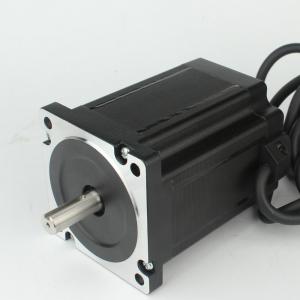

Add to Cart
278oz.In - 972oz.In 2-7N.M 86H3P 1.2 Degree NEMA34 Stepping Motor
Stepping motor is an open-loop control element that converts
electrical pulse signals into angular displacement or linear
displacement. In the case of non-overload, the motor speed and stop
position only depend on the frequency and pulse number of the pulse
signal, and are not affected by the load change. When the stepper
driver receives a pulse signal, it drives the stepper motor The set
direction rotates at a fixed angle, called "step angle", and its
rotation runs step by step at a fixed angle. The angular
displacement can be controlled by controlling the number of pulses,
so as to achieve the purpose of accurate positioning; at the same
time, the speed and acceleration of the motor rotation can be
controlled by controlling the pulse frequency, so as to achieve the
purpose of speed regulation.
NEMA34 Stepping Motor Description:
NEMA34 stepping motor, 86mm 3 Phase square stepper motor.
45kg.cm Stepper motor, high torque stepper motor with 86mm size.
60kg.cm stepping motor.
NEMA34 Stepping Motor Genaral Specification:
| Item | Specifications |
| Step Angle | 1.2° |
| Temperature Rise | 80℃max |
| Ambient Temperature | -20℃~+50℃ |
| Insulation Resistance | 100Ω Min. ,500VDC |
| Dielectric Strength | 500VAC for 1minute |
| Shaft Radial Play | 0.02Max. (450g-load) |
| Shaft Axial Play | 0.08Max. (450g-load) |
| Max. radial force | 75N (20mm from the flange) |
| Max. axial force | 15N |
NEMA34 Stepping Motor Specifications:
Model No. | Step Angle | Motor Length | Current /Phase | Resistance /Phase | Inductance /Phase | Holding Torque | Rotor Inertia | Mass |
( °) | (L)mm | A | Ω | mH | N.m | g.cm2 | Kg | |
JK86H3P65-3006 | 1.2 | 65 | 3 | 0.5 | 1.6 | 2 | 1100 | 1.65 |
JK86H3P98-5206 | 1.2 | 98 | 5.2 | 0.6 | 3 | 4.5 | 2320 | 2.70 |
JK86H3P113-5206 | 1.2 | 113 | 5.2 | 0.9 | 5.9 | 6 | 3100 | 3.50 |
JK86H3P150-5006 | 1.2 | 150 | 5.0 | 1.5 | 3 | 7 | 4650 | 5.10 |
Dimensions:(Unit=mm)
Wiring Diagram:
Stepper Motor Advantages
Low cost for control achieved
High torque at startup and low speeds
Ruggedness
Simplicity of construction
Can operate in an open loop control system
Low maintenance
Less likely to stall or slip
Will work in any environment
Can be used in robotics in a wide scale.
High reliability
The rotation angle of the motor is proportional to the input pulse.
The motor has full torque at standstill (if the windings are
energized)
Precise positioning and repeatability of movement since good
stepper motors have an accuracy of 3–5% of a step and this error is
non-cumulative from one step to the next.
Excellent response to starting/stopping/reversing.
Very reliable since there are no contact brushes in the motor.
Therefore, the life of the motor is simply dependent on the life of
the bearing.
The motors response to digital input pulses provides open-loop
control, making the motor simpler and less costly to control.
It is possible to achieve very low-speed synchronous rotation with
a load that is directly coupled to the shaft.
A wide range of rotational speeds can be realized as the speed is
proportional to the frequency of the input pulses.
Computer controlled stepper motors are a type of motion-control
positioning system. They are typically digitally controlled as part
of an open loop system for use in holding or positioning
applications.
In the field of lasers and optics they are frequently used in
precision positioning equipment such as linear actuators, linear
stages, rotation stages, goniometers, and mirror mounts. Other uses
are in packaging machinery, and positioning of valve pilot stages
for fluid control systems.
Commercially, stepper motors are used in floppy disk drives,
flatbed scanners, computer printers, plotters, image scanners,
compact disc drives, intelligent lighting, camera lenses, CNC
machines and, more recently, in 3D printers.
